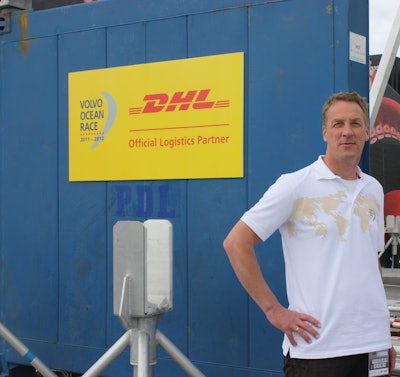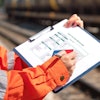
Whether it’s by air, sea or land, DHL impacted the success of the 2011-2012 Volvo Ocean Race thus far in more ways than one. The 11th edition of the race, set to conclude on July 7 in Galway, Ireland, is a mammoth of an operation that requires strenuous preparation by sailors, vessel builders, event organizers, race sponsors and participating sea ports and airports. Designed for six professional teams of 11 crew members in state-of-the-art, 70-foot racing yachts, the race covers 39,270 nautical miles—the greatest distance of any professional sailing event—and crosses four oceans and five continents. And DHL, global logistics provider and the official logistics sponsor of the race, has stood by 24/7 through the extremes of it all to transport equipment and emergency spare parts to ensure the six elite teams can continue in their pursuit for victory.
From past to present
The nine-month race, which started in Alicante, Spain in October 2011, brings a number of firsts, including the first sole Chinese entry, Team Sanya, and the first United Arab Emirates entrant, Abu Dhabi Ocean Racing (other teams include the Groupama sailing team; PUMA Ocean Racing by BERG; CAMPER with Emirates Team New Zealand; and Team Telefónica). Built on the spirit of fearless men who lived on the sea more than a century ago, today’s Volvo Ocean Race serves as a hybrid of world-class sport and live adventure.
“The race began as something of a Corinthian adventure,” explained Kevin Fylan, Editor In Charge, Volvo Ocean Race S.L.U. “Back in 1973, very few people had sailed all the way around the world and it took a remarkable spirit of adventure to undertake such an enterprise. Now, of course, the race is a fully professional operation featuring elite sailors—many of them with world championship, Olympics and America’s Cup experience. The early editions were as much about battling the elements to get through the Southern Ocean and complete the course while today it’s all about winning. Competing in this race is essential if you want to be regarded as an elite sailor—while to be a real success, you have to have won it,” Fylan said.
But unlike other sports or competitions—most often held in closed, controlled settings—the race is based on uncontainable elements, in this case Mother Nature herself. Aside from its main task to ensure that each team’s equipment is delivered to each stopover, DHL shipped critical spare parts weighing hundreds of pounds to four of the six teams throughout the race after the vessels experienced extensive damage.
Delivery is crucial
“This race has been one of the toughest logistical challenges for the teams and organizers as well as one of the world’s most difficult sporting events,” added Fylan. “As the race has gone on, more and more teams suffered problems, testing their logistics operations and the resources of DHL to the limit. We’ve had problems in previous races, of course, but the scale this time has been unprecedented and it’s a tribute to the teams and their partners—the Volvo Ocean Race and DHL—that the six boats were on the starting line in Miami and made it safely across the Atlantic to Lisbon for the final two-sprint legs around Europe.”
Just hours after the six racing teams had sailed away from Alicante, Spain for the start of the race last fall, DHL answered an emergency call to replace a broken mast for the Abu Dhabi Ocean Racing shore crew. In addition, between Leg 5 and Leg 6 of the race, the team’s racing yacht Azzam experienced hull damage while on the Southern Ocean, which led to Abu Dhabi’s Skipper Ian Walker suspending racing in Leg 5 and heading to Puerto Montt, Chile on April 4 to continue repairs. But cyclonic weather forecasts around Cape Horn caused the team to relocate their repair operations, thus requiring DHL to provision a charter vessel to transport Azzam to Itajaí, Brazil. This enabled the crew to make repairs necessary to the vessel in enough time to start in the Itajaí In-Port Race on April 21 and the start of Leg 6 from Miami the following day.
In another case, team Sanya, which suffered hull and rudder damage as it left Auckland, New Zealand at the start of Leg 5 in late March, required DHL to charter a vessel, placing the team’s boat on board and collecting the team’s equipment for transport to Savannah, Ga., for repairs.
DHL also set up the delivery of necessary equipment to Chile where CAMPER with Emirates Team New Zealand stopped to do repairs and where DHL provided a crucial replacement part for PUMA Ocean Racing powered by BERG in Auckland.
DHL overcomes its challenges
Perhaps one of its most challenging tasks was during Legs 2 and 3 of the race, during which DHL helped the race bypass pirate-infested waters off the coast of Somalia by moving the sailing yachts on ocean tankers.
“That was a very, very challenging operation which had never been done before,” explained Reinier Vens, Project Director, DHL for the Volvo Ocean Race. “We had to lift all the race boats out of the open sea onboard the chartered ship using the crane on the cargo ship, and bring them to Sharjah in the United Arab Emirates—and from there bring them to Abu Dhabi. Everything needed to be planned. It involved many divisions of DHL as well—the industrial projects team, the chartering group—all of the whole DHL operations. And at the end of the day, everybody was happy the operation went well.”
A crucial task—both before the start of the race and throughout—also included scheduling of the 25 tons of materials, from small-to-large scale supplies such as food; clothing; first aid kits; desks; refrigerators; 105-foot tall masts and more.
“We had to schedule everything well in advance and plan everything with the shipping lines and verify that all documentation was correct,” said Vens. “We also had to ensure that health authorities were spoken to because of freeze-dried food onboard the teams’ ships. Importing food into a country is always a very complicated issue and something we needed to address well in advance.”
“The second issue in this race was going to destinations which are not like Miami, for example, which has a good logistics infrastructure,” he continued. “These racing vessels are also going to destinations like Itajaí in Brazil and Hainan in China. And we needed to ship the necessary containers to these destinations. We needed to schedule a whole operation because the timeframes were so tight and charter vessels needed to be booked.”
One island that lacked practically all infrastructure and required DHL to charter a vessel that could access its tiny port, was Tristan da Cunha, located in the South Atlantic Ocean. PUMA Ocean Racing by BERG, was one such team that was able to quickly get back into the race after such necessary charter vessel scheduling by DHL.
“We were pretty fortunate—our boat itself got around the world pretty unscathed,” said Ken Read, Chief Executive Officer, PUMA Ocean Racing and Skipper of PUMA’s Mar Mostro yacht. “But we did have some setbacks. One was when we broke our mast in the middle of the Atlantic Ocean—and that’s not the best situation. So we had to do several things. We had to figure out how to get without a mast or sails from the middle of the ocean to South Africa. Once we got there, we had to get our boat back into one piece in order to start leg 2 of the race. The boat and crew ended up in Tristan da Cunha which is the most remote, inhabited island in the world—no airport, nothing. I believe they get about six ships per year that bring supplies and goods to the island, which has 262 people total. And they took care of us for five days while our shore team managed to commandeer about a 350-foot ship to pick up our boat with the ship’s crane, get the boat on deck and take us to South Africa. Everything had to happen very fast and it was a challenge,” Read said.
Utilizing a “leap frog” process throughout the race, DHL moved two identical sets of containers for each team, shipping a total of 152, 40-foot containers to 10 different stopovers around the world by conclusion of the race. While the first container was used during one leg of the race, DHL delivered the second container to the next destination. Furthermore, each team also had two airfreight containers shipped to each stopover. Upon arrival, the teams took over the second container to use it during the next leg while DHL prepared the previously-used container for the next stopover. The method was necessary to guarantee on-time delivery because the Volvo Open 70 vessels used by each of the six teams are much faster than commercial vessels. DHL’s warehouse, near the airport in Amsterdam, additionally had to be large enough to store the racing teams’ massive vessel parts, such as 105-foot tall, 1,700-pound masts.
“We rely on so much material being brought around the world for us,” said Read. “We have to duplicate every single thing we have in order for DHL to leap-frog our containers from port to port around the world. Just that alone becomes pretty stressful logistically. Then you mix in the fact that a lot of the key items being transported are very expensive—bottom line is I’m glad I’m a sailor and don’t have to deal with the logistics of it all,” laughed Read.
Race to the finish
While the No. 1 goal for each of the teams is to be the first to cross that finish line, to be able to look back at the past year and the challenges that they each faced and overcame with the help of DHL is a feat in itself. And while changes for the 2014-2015 race are expected—as goes with anything that is bound to change within days and months let alone years—the accomplishments that each of the teams and all folks involved achieved throughout the race will not be forgotten easily.
“We’re not there yet but the biggest accomplishment will always be finishing the race,” said Read. “Don’t get me wrong—we’re in this to win. But from a safety standpoint, this is a dangerous sport and I never want to make that call to a wife to say ‘your husband is not coming home.’ Win, lose or draw—that would be our biggest accomplishment—to have the same 11 guys on the boat when we cross that finish line as when we started the race.”



















